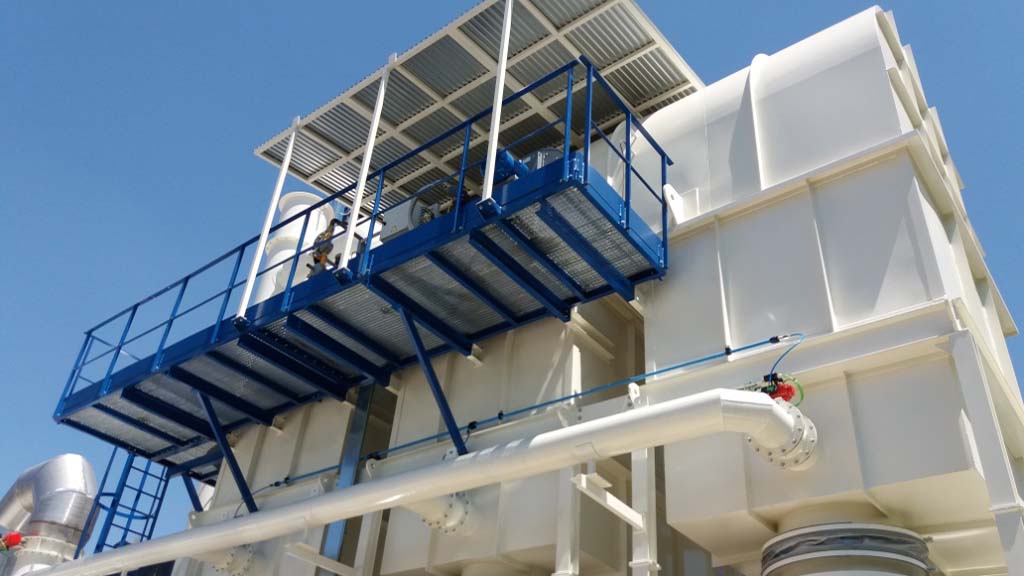VOC reduction in the printing-, painting- and coating industry
The printing, painting and coating industries are constantly confronted with emissions, odours and toxic vapours from press rooms, print dryers, ovens, mixing systems and cleaning products. VOC have been proven to be hazardous to human health and have significant environmental impacts. One possible way to deal with such emissions is an RTO.
VOC in the printing, painting and coating sector
Liquid paints, lacquers, varnishes, inks and adhesives based on organic solvents contain a certain quantity of volatile organic compounds (= VOC) such as alcohols, glycols, esters, hydrocarbons and ethers (e.g. toluene, benzene, butane, methane, isopentane, ethane, ethylene, pentane, propane). Many volatile organic compounds are released when, for example, mixing components in open mixing systems, cleaning machines with solvents or when coating is applied, at the level of the flash-off zones and in the drying ovens. The VOC content varies according to the printing methods. Heatset inks are among the largest polluters. They consist of 35-40% VOC. In gravure and flexographic printing, the inks can contain up to 70% VOC. In view of the negative impact on people and the environment, there are strict guidelines regarding VOC emissions. In addition to VOC, HAPs (hazardous air pollutants), unpleasant odours or toxic gases can also be released.
Air pollution control regulations
In response to the danger posed by VOC and other emissions to people and the environment, Europe and Belgium have issued a number of guidelines in this respect. For humans, VOC can cause odour nuisances, respiratory tract irritation, but also respiratory problems and loss of consciousness in extreme cases. For prolonged exposure, the neurotoxic and carcinogenic properties of some VOC must be taken into account. For the environment, it is important that we avoid VOC and other emissions reacting with nitrogen oxides in the presence of heat and sunlight, thus creating ground-level ozone. The Clean Air Act legislation and its enforcement by the EPA-regulating bodies are based on this.
Here you can see which guidelines the industry must adhere to.
RTO as a solution
Ideally, as few organic solvents as possible should be used. However, in some situations, this is inevitable. A post-treatment of VOC emissions ensures controlled emission.
One way of rendering volatile organic compounds and other air pollutants harmless is to oxidise them with oxygen at high temperature. By initiating an incineration reaction, the air pollutants are oxidised and converted into harmless products such as CO2, H2O and usable heat. For this purpose, PCA Air offers the regenerative thermal oxidator (RTO) as the most effective and cost-efficient solution.
A RTO is an air pollution control device in which the polluted process air is in most cases pushed through three ceramic beds. In the first ceramic bed, the process air is heated to the combustion point. The air therefore undergoes oxidation. The warm and clean air is then led down through the second ceramic bed, where the air is cooled. Finally, there is also a third ceramic bed, which is cleaned. In this way we get an effluent flow that is as constant as possible. The heat released by such regeneration of the heat exchanger ensures a thermal efficiency of up to +- 95%, which is much higher than the traditional recuperative heat exchangers.
RTO is also designated by the Flemish BBT knowledge centre as one of the best available technique for the printing industry. Fuel is only used if the system has been idle for a weekend. The waste streams therefore often contain VOC concentrations around or above the autothermal point. Finally, there are also dryers with a built-in thermal burner, but according to the BBT knowledge centre it is more reliable and cheaper in the long run to install one central RTO.
For the paints, lacquers, varnishes, printing inks and adhesives industry BBT recommends the following: if possible, try to use as few organic solvents as possible. In situations where it is unavoidable, they recommend treating the VOC emissions with a RTO in order to achieve controlled emissions.
Different applications
Our solution can be applied in many of the different applications within the print-, paint- and coating sector, such as:
- Flexographic printing
- Lithographic printing
- Engraving Printing
- Digital printing
- Car paints
- Dip coating
- Cleaning
- Mixing tanks
- ...
Are you working in the print-, paint- and coating industry? Are you looking for a suitable solution for your VOC? Or are you just looking for a RTO? Be sure to contact us so that together we can see what we can do for you.

